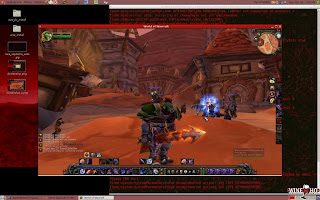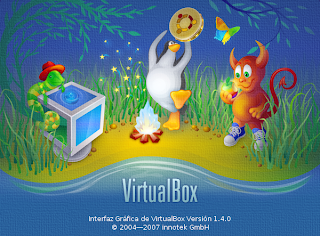VirtualBox is the competitor of qemu, vmware, xen, parallels ... , Which also is distributed free to end users under the GPL (opensource version, the binaries are subject to certain restrictions)
1 - Installation
2 - Add vboxguestadditions
3 - Keyboard shortcuts
4 - Add shared directory
5 - Networking (in progress)
6 - Add USB
fixture by Installation
To download, just have to download the. deb package for our distribution since:
http://www.virtualbox.org/wiki/Downloads
Then install it with:
$ sudo dpkg-i nombredelpaquete.deb
in edgy I have not had any problems dependency but if you find one, try the following units:
libqt3-mt
libxalan110 libxerces27
 The program is very intuitive so I will not explain how to create virtual machines-
The program is very intuitive so I will not explain how to create virtual machines- If after installing the virtual machine we launch an error on a program module (VBox status code: -1909 VERR_VM_DRIVER_NOT_ACCESSIBLE), is arranged with:
 launched VirtualBox, we went to settings and click on the tab cd / dvd. From there choose
launched VirtualBox, we went to settings and click on the tab cd / dvd. From there choose "Mount CD / DVD drive" and mark "iso image file." If it does not default "VBoxGuestadditions.iso" we give and what we chose to select from there (in linux is on / opt/VirtualBox-1.3.2/additions/VBoxGuestAdditions.iso).
If the guest system is Windows (not support Windows 98):
be as simple as turn to our cdrom drive within the guest and click on the. Exe
- If the guest is linux system before we get off the gcc compiler The make and the headers of your kernel. The following is from a terminal to the guest system:
- $ sudo aptitude install gcc-4.0 # gcc to choose that compiled your kernel $ sudo aptitude install
make $ sudo aptitude install linux-headers-`uname -r `
Now we say that using gcc compiler:
$ sudo ln-s / usr/bin/gcc-4.0 / usr / bin / gcc
Now we see if the cdrom is mounted, if are not, do:
$ mount / dev / cdrom directory _Que _dde _queremos _It _monte # This last parameter is optional
Now we stand within the directory where you mounted the cdrom and do$ sudo. / VBoxlinuxAdditions.run
If it does not run the file permissions issues, thou must copy the vuestar eg user folder in home and give it execution permissions: $ cpVBoxlinuxAdditions. run / home / username
$ cd # with this simple command will place us in / home / nombre_de_usuario_actual
$ sudo chmod-R 777 VBoxlinuxAdditions.run
- And now if you can do: $
sudo. / VBoxlinuxAdditions.run
Restart the guest system-
-
CTRL (right) to get the mouse pointer of the guest to host CTRL (right) + F: to enter or exit full screen
CTRL (right) + DEL: send a CONTROL + ALT + THE CTRL
the guest system (right) + BACKSPACE: send a CONTROL + ALT + BACKSPACE to guest system ....To add a shared directory do: (requirement is to have already installed the vBoxGuestAdditions)
$ VBoxManage sharedfolder add "nombremaquinavirtual"-name "unnombre"-hostpath "directorioacompartido"Now to access the partition from a guest system to do (according to applicable):
For Windows guest system - type in the terminal window (command.com):
net use x: \\ \\ vboxsvr \\ unnombreYou can also add the directory by right clicking on My Computer select "connect to network drive." In unity we choose the letter you want for the folder shared folder and write "\\ \\ vboxsvr \\ unnombre"
For linux guest system - type in a terminal: mount-tvboxsf unnombre mountpoint
To disable the shared directory
$ VBoxManage sharedfolder
remove "nombredelaquinavirtual"-name "nombredeldirectoriocompartido"
Networking (in progress) First, NAT is by far the easiest way to connect the guest to the network, but in case you want to make a server (give it a own ip) with sisteaa guest, you should enable host-networking.
need to download the following dependencies to create the tap device and add it to the bridge: -
- $ sudo apt-get install bridge-utils uml-utilities
tunctl sudo-u-t tap1 name # where name refers to the username that will run virtualbox
Now draw a bridge and put your interface at: $
- $ sudo chmod 666 / dev / net / tun
Making a new bridge called br0$ sudo brctl br0 addbr
Put your current interface (in this case eth0) in promiscuous mode (I read somewhere that using the promiscuous mode is security risk, warned YOU ARE), then add it to the bridge and give the bridge an address dhcp-
$ sudo ifconfig eth0 0.0.0.0 promisc sudo
br0 eth0 brctl addif $ dhclient br0 -
tap1 adds the new device to bridge
$ sudo brctl br0 addif tap1
Now you should be able to use host networking in VirtualBox, just change "attached to" a "host interface and adds the interface name tap1 in your network configuration.Read the manual also, there are other ways to do this.
adding extra information: -
- Some things to make the following easier to understand. My eth0 on my host is 192.168.0.45. My tap0 is going to be 192.168.0.94 (totally arbitrary .. make him a ping first, to be sure it is free. The user (user) in the first command is the user that these logged (which I assume will be the same runs with VirtualBox). 7 steps are the same as the previous post. The following are added as needed to run: $ sudo
tunctl-t tap0-u user
$ sudo chmod 666 / dev / net / tun$ sudo / usr / sbin / brctl br0 addbr $ sudo / sbin / ifconfig eth0 0.0.0.0 promisc $ sudo / usr / sbin / brctl addif
br0 eth0 $ sudo / sbin / dhclient br0$ sudo / usr / sbin / brctl $
addif br0 tap0 sudo ifconfig tap0 192.168.0.94 up sudo bash-c 'echo 1> / proc/sys/net/ipv4/conf/tap0/proxy_arp' $ sudo route add-host 192.168.0.45 dev tap0 $ sudo arp-Ds 192.168.0.45 eth0 pub
virtual machine.
Add tap0 as VirtualBox name in the tab "Virtual machine / Network Tab / Adapter 0" Save and run
Just add the host IP address from the guest is: 10.0.2.2
How to add a fixture by USB.
Supports both 1.1 and 2.0 devices, although a small part of the code is based on qemu, there is no restriction to any USB device, all should work. As an example, the bluetooth was not supported by qemu and whether he is here, tested. Createusbusers group and add the user who launched the group virtualbox usbusers. (System-administration-users and groups management groups añladir groups)
In a terminal type:
$ VBoxManage list usbhostUUID: 5763f299-2206-4eb1-b283-998feb4d7ea4
Vendor: 0x0a12 (0A12)ProductId: 0x0001 (0001) Revision: 5.37 (0537) Address: / proc/bus/usb/001/004
Current State: Busyand keep the numbers and vendor ID from USB device you want to enable. In the section of the virtual machine settings on the USB tab, add the previous numbers where appropriate. Stay
also with the line that says the address of the device:
Address: / proc/bus/usb/001/004
Now we write permissions, read and execution on the device:$ sudo chmod 777 / proc/bus/usb/001/004
none / proc / bus / usb usbusers Devgan = 1002, devmode = 664 0 0
Or you can launch
virtualbox as root: $ sudo
VirtualBox
Another way is by editing / etc / fstab and adding a group (I've called usbusers). Inclusive line to the / etc / fstab: # 1002
the group with access to USB
fixture by adding extra information about usb
Please read chapter 5.1.6 of the user manual http://www.virtualbox.org/download/UserManual.pdf - permits the user running VirtualBox should allow access (read / execute) to the corresponding device USB found in "/ proc / bus / usb / *". USB device permissions found in this directory are selected by udev, according to the type of device. For example, a USB scanner is assigned to the group "scanner". Please check first that should enter the device file VirtualBox, "lsusb-v" should tell you the number of device / USB, then check the permissions of that file. Should require udev rule in / etc / udev. If your distribution does not use udev can permanently change permissions with chmod.
HowTounder the terms of the Creative Commons license. More information here:
http://creativecommons.org/licenses/by-nc-sa/2.5/es/deed.es
http://doc.ubuntu-fr.org/virtualbox
Sources:
http://www.virtualbox.org/wiki/User_FAQ
http://www.ubuntuforums. org / showthread.php? t = 338931
http://forum.ubuntu-fr.org/viewtopic.php?id=89503&p=1
https: / / help.ubuntu.com / community / http://www.ubuntuforums.org/showthread.php?t=341740
VirtualBoxhttp://vbox.innotek.de/pipermail/vbox-users/2007-January/000036.html
http://www.ubuntuforums.org/showthread.php?t=346185
0 comments:
Post a Comment